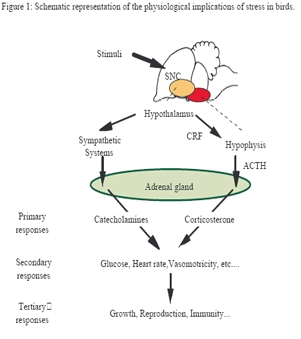WP 5: Physiological stress indicators
The objective of WP5 was to find and formulate physiological parameters that give objective information on the actual stress levels of laying hens and therefore will be a help in assessing the welfare situation of laying hens in furnished cages and alternative housing systems.
WP5 puts emphasis on:
- Physiological parameters for the assessment of acute and chronic stress of laying hens (corticosterone concentrations in blood and faeces, heterophyl/lymphocyte (H/L) ratio, humoral responses)
- Physiological stress responses in furnished cages and alternative housing systems, taking into account differences in hybrids, climate and management across Europe.
The output of WP5 is a report presenting the review of the literature and new research results on physiological stress parameters and physiological stress responses in furnished cages and alternative housing systems. The review was made in the first year of the LayWel project. In the second year new research findings were added.
Apart from defining the best physiological indicators, also research was conducted to see if birds in different housing systems have a different physiological response and thus may experience differences in stress. For this data were compiled from 16 independent experiments, provided by five LayWel’s partners. As a consequence, the experiments differed first in their scientific objectives but also in numerous other aspects including rearing and housing conditions or densities, as well as the genotypes which entered the study, which made it difficult, if not impossible, to reach firm conclusions. Depending upon the parameter chosen it could be concluded that welfare was improve, comparable or decrease in furnished cages or alternative systems compared to conventional cages. Despite these contradictions one can not conclude that physiological indicators are not relevant to assess welfare. Indeed, it illustrates the risk of misinterpretation that can result by taking into account a single or a limited number of welfare indicators of the same category and-or to conclude from a single study or by concluding using only one genotype. Moreover, some original and interesting findings have come out of this work package.
First, it is of major importance to keep in mind before drawing firm conclusions that the responses measured for the different physiological indicators differed depending upon genotypes and/or the period of lay. Therefore, differences in levels of responses should not be misinterpreted. Moreover, results originating from different independent studies have shown that there is strong interactions between the physiological responses measured during the laying period and the conditions to which the pullets were submitted during the rearing period. This observation clearly indicates that this initial period of life is of primary importance for a better adaptation of the hens to their future housing conditions and consequently their welfare. A second major finding is that there is no evident negative effect of the density in floor system or of the cage system (conventional vs. furnished) as such, whereas one specific cage model can be at the origin of different responses. Fourth, consequences of beak trimming can be controversial in term of welfare and care should be taken before banning this possibility to prevent feather pecking and cannibalism occurrence in some strains. Last but not least, in this context the selection against feather pecking is an interesting approach, which have been shown to be successful and such selection programs seems to be positively associated with lower HPA axis reactivity to stress in low feather pecking hens.
| Description | download |
| 5.4 Physiology and stress indicators (final report) | |
| 5.4 Physiology and stress indicators Annexes (final report) |